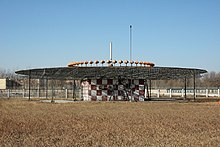
Back نظام الملاحة اللاسلكي غير محدد الاتجاه ذو الترددات شديدة الارتفاع Arabic Всенасочен УКВ радиофар Bulgarian Radiofar omnidireccional en VHF Catalan VOR (radiomaják) Czech VHF omnidirectional range Danish Drehfunkfeuer German VOR Greek Radiofaro omnidireccional VHF Spanish VHF ringsuunaline raadiomajakas Estonian VHF-monisuuntamajakka Finnish
This article needs additional citations for verification. (September 2018) |



Very High Frequency Omnidirectional Range Station (VOR)[1] is a type of short-range VHF radio navigation system for aircraft, enabling aircraft with a VOR receiver to determine the azimuth (also radial), referenced to magnetic north, between the aircraft to/from fixed VOR ground radio beacons. VOR [2] and the first DME(1950)[3] system (referenced to 1950 since different from today's DME/N) to provide the slant range distance, were developed in the United States as part of a U.S. civil/military programm for Aeronautical Navigation Aids in 1945. Deployment of VOR and DME(1950) begann in 1949 by the U.S. CAA (Civil Aeronautics Administration). ICAO standardized VOR and DME(1950) in 1950 in ICAO Annex ed.1.[4] Frequencies for the use of VOR are standardized in the very high frequency (VHF) band between 108.00 and 117.95 MHz[5] Chapter 3, Table A. To improve azimuth accuracy of VOR even under difficult siting conditions, Doppler VOR (DVOR) was developed in the 1960s. VOR is according to ICAO rules a primary means navigation system for commercial and general aviation,[6][7] (D)VOR are gradually decommissioned[8][9] and replaced by DME-DME RNAV (area navigation) [5] 7.2.3 and satellite based navigation systems such as GPS in the early 21st century. In 2000 there were about 3,000 VOR stations operating around the world, including 1,033 in the US, but by 2013 the number in the US had been reduced to 967.[10] The United States is decommissioning approximately half of its VOR stations and other legacy navigation aids as part of a move to performance-based navigation, while still retaining a "Minimum Operational Network" of VOR stations as a backup to GPS.[11] In 2015, the UK planned to reduce the number of stations from 44 to 19 by 2020.[8]
A VOR beacon radiates via two or more antennas an amplitude modulated signal and a frequency modulated subcarrier. By comparing the fixed 30 Hz reference signal with the rotating azimuth 30 Hz signal the azimuth from an aircraft to a (D)VOR is detected. The phase difference is indicative of the bearing from the (D)VOR station to the receiver relative to magnetic north. This line of position is called the VOR "radial". While providing the same signal over the air at the VOR receiver antennas. DVOR is based on the Doppler shift to modulate the azimuth dependent 30 Hz signal in space, by continuously switching the signal of about 25 antenna pairs that form a circle around the center 30 Hz reference antenna.
The intersection of radials from two different VOR stations can be used to fix the position of the aircraft, as in earlier radio direction finding (RDF) systems.
VOR stations are short range navigation aids limited to the radio-line-of-sight (RLOS) between transmitter and receiver in an aircraft. Depending on the site elevation of the VOR and altitude of the aircraft Designated Operational Coverages (DOC) of at max. about 200 nautical miles (370 kilometres) [5] Att.C, Fig.C-13 can be achieved. The prerequesite is that the EIRP provides in spite of losses, e.g. due to propagation and antenna pattern lobing, for a sufficiently strong signal at the aircraft VOR antenna that it can be processed successfully by the VOR receiver. Each (D)VOR station broadcasts a VHF radio composite signal, including the mentioned navigation and reference signal, and a station's identifier and optional additional voice.[5] 3.3.5 The station's identifier is typically a three-letter string in Morse code. While defined in Annex 10 voice channel is seldomly used today, e.g. for recorded advisories like ATIS.[5] 3.3.6
A VORTAC is a radio-based navigational aid for aircraft pilots consisting of a co-located VHF omnidirectional range and a tactical air navigation system (TACAN) beacon. Both types of beacons provide pilots azimuth information, but the VOR system is generally used by civil aircraft and the TACAN system by military aircraft. However, the TACAN distance measuring equipment is also used for civil purposes because civil DME equipment is built to match the military DME specifications. Most VOR installations in the United States are VORTACs. The system was designed and developed by the Cardion Corporation. The Research, Development, Test, and Evaluation (RDT&E) contract was awarded 28 December 1981.[12]
- ^ "Ground-Based Navigation - Very High Frequency Omni-Directional Range (VOR)". www.ecfr.gov. Federal Aviation Administration. Archived from the original on 2022-05-22. Retrieved 2021-11-29.
- ^ Report 540-2, Vol.I, Final Report on Evaluation of Omni-Bearing-Distance System of Air Navigationm, by W. R. Rambo, J. S. Prichard, D. P. Duffy, R. C. Wheeler, A. E. Dusseau, Jr., and S. Goldstein, October.1950.
- ^ TDR-114 (Technical Development Report No. 114), UHF Distance Meassuring Equipment for Air Navigation, By. R. C. Borden, C. C. Trout and E. C. Williams Electronics Division, June 1950.
- ^ ICAO, International Standards and Recommended Practices, Aeronautical Telecommunications, Annex 10, ed. 1, Mai.1950.
- ^ a b c d e ICAO, International Standards and Recommended Practices, Vol. I Radio Navigation Aids, Annex 10, ed.8, July.2023 https://elibrary.icao.int/reader/299828/&returnUrl%3DaHR0cHM6Ly9lbGlicmFyeS5pY2FvLmludC9wcm9kdWN0LzI5OTgyOA%3D%3D?productType=ebook.
{{cite book}}: External link in|title= - ^ VOR VHF omnidirectional Range Archived 2017-04-24 at the Wayback Machine, Aviation Tutorial – Radio Navaids, kispo.net
- ^ Kayton, Myron; Fried, Walter R. (1997). Avionics navigation systems, 2nd Ed (2nd ed.). USA: John Wiley & Sons. p. 122. ISBN 0-471-54795-6.
- ^ a b "Has GPS killed off the VOR?". 29 May 2015. Archived from the original on 24 July 2021. Retrieved 19 September 2021.
- ^ "Airservices to begin turning off ground-based navaids from May 26". 26 May 2016. Archived from the original on 5 December 2021. Retrieved 19 September 2021.
- ^ Department of Defense appropriations for 1983 Archived 2021-12-20 at the Wayback Machine, pt. 2, p. 460.